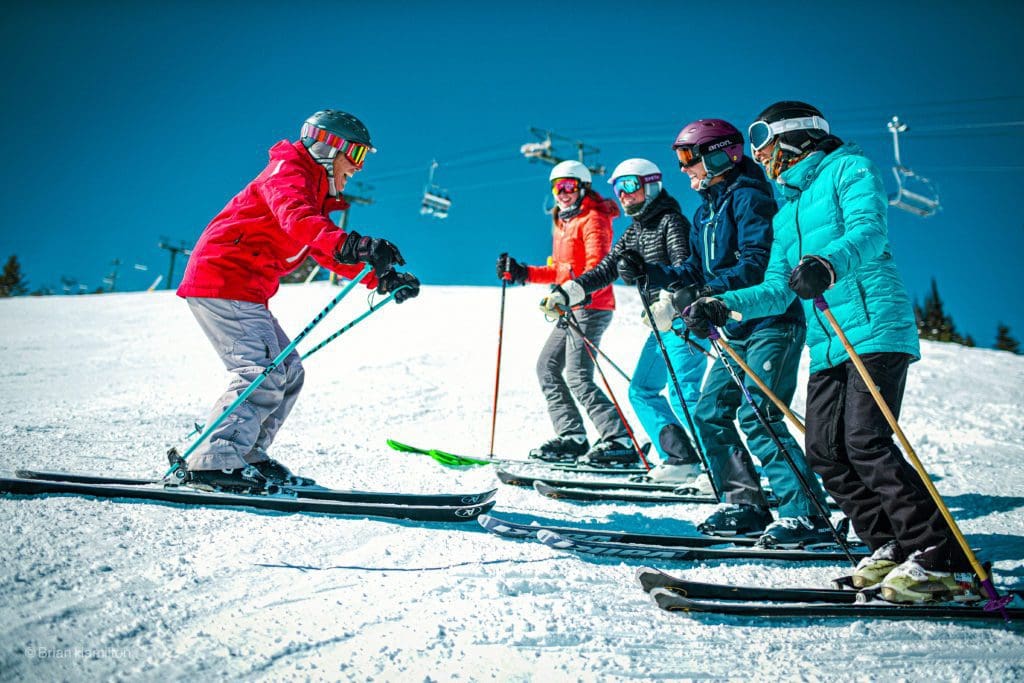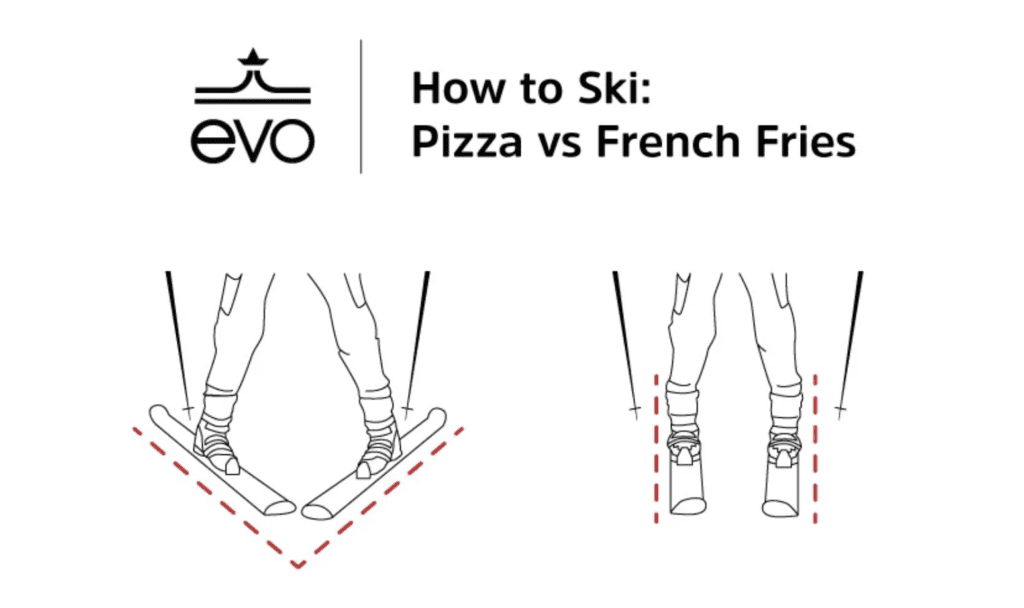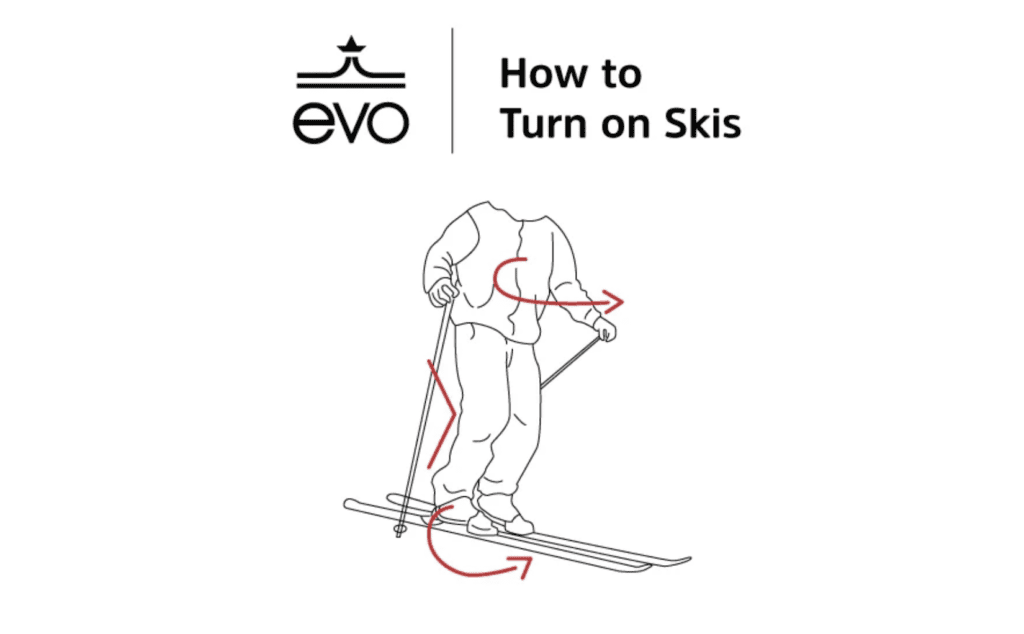|
Getting your Trinity Audio player ready...
|
So you’re going skiing for the first time. Maybe you’ve looked forward to this for years, maybe you just booked a ski vacation at the last minute – either way, prepare for the ride of your life! It’s hard to beat the thrill of a great day on the slopes, but the learning curve for beginner skiers can be steep. Unlike some sports, at first, skiing can be very counterintuitive. So we’ve put together this comprehensive introduction to skiing as a beginner, from how you prepare the night before, what to bring skiing, all the way to your first turns on the bunny hill. Read along for tips for your first day skiing.
How to Prepare For a Day Skiing
Sure, you can just jump in cold turkey and drive to a ski hill, and figure it out when you get there, but it’s best to plan ahead and have some things set up beforehand to save you time and money. So here are a few things beginner skiing tips that you can use to set yourself up for success.
Buy Your Lift Ticket Online
More and more ski resorts are offering online ticket sales, often at a slight discount. Buying your ticket online ahead of time can save you a lot of time and hassle. No one wants to wait in a long line in the cold first thing in the morning. So shop online and beat the rush.
Shop for Beginner Ski Packages
Ski resorts love first-time skiers, they exist to help more people fall in love with the sport after all. So many hills offer discounted packages that include a lift ticket, gear rental, and a lesson. These ski packages are always your best option when first trying the sport. They’re designed to help you become a competent skier with as little hassle as possible, for the lowest price possible – take advantage of them.
Stretch & Hydrate
This one might seem obvious, but skiing uses muscles that don’t get much action in everyday life. After your first day of skiing you’ll be sore in places you didn’t even know you had. Make sure to stretch well before heading to the slopes. Making sure you’re well hydrated is important as well, ski areas are at high altitudes, and you’ll be working hard out there. Your body will thank you for it, and you’ll reduce the risk of injury.
What to Wear Skiing
For many first time skiers, their outfit ends up being the weak link that makes their day miserable. Be prepared, and you won’t end up with cold fingers and toes that force you to go home early. We’ve put together a complete guide to how to dress for skiing here, but here’s a breakdown of the basics.
- Bring more clothes than you think you need. You don’t lose anything by stockpiling a few warm layers, and extra gloves in your car, and you could end up being really grateful you did.
- Don’t Wear Cotton Skiing. There’s an old adage in the outdoor world “cotton kills.” That’s because when cotton clothes get wet, either from snow, or sweat, they take forever to dry out, and they lose all of their insulation. So you end up cold and wet immediately. Don’t wear anything cotton. Instead wear wool or synthetic socks, underwear, and insulating layers.
- Dress for the Chairlift. Often skiers dress like they would to go sledding or ice skating. That’s a bad idea. For those sports you’re moving most of the time and stay naturally warmer. As a skier, you’ll spend a lot of time on the chairlift. That means you’ll be sitting out in the cold, off the ground, potentially with a cool breeze blowing. Wear warm enough clothes that you’d be comfortable sitting still outside, because you will be.
What to Bring Skiing
Skiing is a sport unlike any other, and as such, it can be hard to make sure you’ve packed everything you need. Do a quick mental check before you leave your driveway and make sure you have everything. So here’s a quick checklist for the car.
- Ski clothes & extra layers
- Skis (if you’re not renting at the mountain)
- Ski Boots (if you’re not renting at the mountain)
- Ski Poles (if you’re not renting at the mountain)
- Wallet
- Lift ticket confirmation (if you purchased online)
- Snacks
- Water
- Dry change of clothes for the drive home
When You Arrive at the Mountain
In the Parking Lot
It depends ski area to ski area how close to the lifts you can park. However, it’s always a good idea to plan on being self-sufficient once you leave your car. That way, if it’s a long way from the lodge to the parking lot you don’t have to make multiple trips and waste your day. So make sure you’re good to go at the car. Make sure you’ve got your wallet and lift ticket in secure, zippered pockets. Make sure you’ve got your snacks and a small water bottle. Because it’s cold, people often forget to drink enough water, and end up really dehydrated. Make sure you’re fully ready to go before you leave the car. And make sure not to lock your keys inside it.
At the Base Area
Always take care of your lift ticket first. If you purchased it online, there should be a note on where to go to redeem it. Don’t get in the general lift ticket line if you don’t have to – it’s usually longer. Once you’ve got your ticket, put it on your snow pants, not your jacket. If it warms up through the day, you may want to take your jacket off, but if your ticket is on it, you’re stuck with it.
The people who give you your ticket can point you toward the gear rental shop. Once there, be patient with the person helping you pick gear. They have a lot of experience helping new skiers, so listen to their advice, it might seem counter-intuitive, but in the long run you’ll be thankful you did. Putting on ski boots for the first time can be a major hurdle for most people. So we’ve put together this guide to putting on & fitting ski boots.
Should You Take A Ski Lesson?

A group of beginning skiers enjoy a ski lesson at Sun Valley Resort near Ketchum, Idaho. The Sun Valley SnowSports programs on Bald Mountain are fun for all ages. Photo Credit: Courtesy Sun Valley Resort, Photographer: © Hillary Maybery.
Once you’ve got your gear, we highly recommend that you sign up for a lesson. Sure, you can figure out how to ski on your own, but it takes a long time, and involves crashing, a lot. Instead, we highly recommend that everyone take a lesson. You’ll learn the fundamentals in a controlled environment, and save yourself a lot of pain.
In addition to providing specialized coaching to help you master the fundamentals, taking a lesson is also a great way to learn your way around the mountain and figure out what sort of runs you are capable of. Lessons are built around the idea of progression: growing throughout the day in your confidence and skills as a skier. Instructors are really good at picking terrain and techniques that will push your ability in a safe environment and make you a better skier. Even if you’ve skied a few days in the past, a lesson to start the day is always a good idea.
How to Get On and Off Chairlifts on Skis
Chairlifts are one of the most intimidating parts of skiing, but they don’t need to be. The most important thing is to pay attention in the lift line. There’s a structured pattern to how people load the lift, and if you pay attention it will make a lot more sense. If you take a lesson, your instructor will help make sure you’re prepared to ride the lift. If you’re still worried, you can always let the attendant know that this is your first time. They can help make sure you get where you’re supposed to be, and can even slow down the lift as you load to make it less intimidating. As long as you pay attention and communicate well, chairlifts are safe and easy. As you slide into the line, make sure to take your pole straps off your wrists, and if you’re wearing a backpack, slide it onto one shoulder, or take it off and put it in your lap, so it doesn’t hit the chair. Shuffle up to the marked loading line on the ground and look back over your shoulder as the chair comes toward you. Sit down on it and lift your tips and you’re good to go.
When getting off the chair, make sure to lift the restraining bar when you see signs as you near the top. Keep the tips of your skis up as you near the loading dock, and as you slide past the line on the ground, stand up and let the chair gently push you down the ramp. Pay attention to the people around you, and maybe even communicate which way you’re going before you get off the chair, so you don’t get tangled up on the ramp. It’s important to clear the unloading area quickly so that there’s room for the folks behind you.
Shop Evo’s Beginner Ski Packages
evo has everything a beginner needs to get started in skiing in a complete package.
How to Ski – Basic Technique for Beginner Skiers
You’ve got the gear, you’ve got your ticket, you’re ready to ride the lifts, what comes next? The fun part of course! It’s time to learn how to ski. At its core, skiing is all about making turns to control your speed down a hill. Turns don’t just change the direction you’re going, they slow you down too. If you take a lesson, your instructor will go over all of this with you, but if you don’t, here’s some basic beginner skiing tips to keep in mind.
It’s All About Your Edges
The most important part of your skis is the little metal parts along the edge of your bases. These dig into the snow and allow you to turn and stop. You control them by tilting your skis side to side. Your skis will naturally want to turn whichever way you lean them, since leaning engages their inside edge.
Pizza and French Fries on Skis
Nope, pizza isn’t just for the lodge cafeteria. It’s also one of the first basics you should master. Pizzaing is when you wedge your skis so that the tips are closer together than the tails. This pushes snow and slows you down. This is the first skill you should work on, it’s the basis everything else is built on. French frying is when your skis are parallel, this allows you to go faster. French fry is fast, pizza is slow, both are delicious!

Pizza and French Fries on Skis. Image by Evo.
How to Turn on Skis
Turns come from your whole body. To turn on skis, look where you want to go, engage your core, swivel your hips, bend your knees, and roll your ankles to turn. So try to make sure you’re not just focusing on one part of your body. Beginner skiers have a tendency to try to do everything with just their ankles, forcing the skis to turn. This is really tiring and makes it hard to stay in control. Instead, pivot and lean with your whole body.

How to Turn on Skis. Image by Evo.
How to Stop on Skis
Anyone can go fast on skis, maybe not Mikaela Schiffrin fast, but fast enough to be out of control – stopping is often the hard part for beginner skiers. Before you leave the bunny hill you need to learn how to hockey stop. A hockey stop is when you swivel both skis so that they’re perpendicular to the direction the slope is going. This allows you to use your edges to stop very quickly. The key to hockey stopping is finding the natural pivot point of your skis. This is usually about halfway from the front of your boots to the tip. Imagine a pin there that your ski rotates around, and use your hips to initiate a swivel around that point. This technique takes some practicing, but once you’ve got it you can stop just about anywhere.
Tips to Stay Comfortable Throughout the Day Skiing
- Wear sunscreen. Even if it’s overcast, any sun will reflect up from the snow and burn your nose and face. It’s a good idea to put on sunscreen at the beginning of the day and at lunch.
- Keep your phone warm. Cold kills phone batteries. Store your phone in a zippered pocket inside your jacket to keep it warm. That way you won’t miss that special photo because your phone is dead.
- Keep your goggles off your forehead. When you go inside the lodge it’s tempting to hang out with your goggles up on your forehead. If you do, they will fog and never clear up. The sweat from your skin fogs them up. Instead take them all the way off and hang them from a hook in the lodge.
- Call it quits before you think you’re too tired to keep skiing. Most injuries happen at the end the of the day when you’re tired and just trying to get that “one more run.” Stop skiing while you’re still having fun, save your legs for another day.
The Best All Mountain Skis of 2023
Take a deep dive into evo’s top picks for the best all mountain skis of 2023
The hunt for the perfect all mountain ski is a tale as old as skiing itself. Choosing a pair of skis to do it all, every day of the season, through powder and ice and groomers and steeps, is no easy task. Luckily for us, dedicated ski designers have been chasing this Holy Grail long enough to have gotten pretty darn good at it. With options of daily drivers built for riders of all styles and ability levels, the time of the elusive “one ski quiver” seems to be close at hand. This list of the 10 Best All Mountain Skis of 2023 features a host of versatile skis around 100mm in width designed to handle every facet of resort skiing. The category of all mountain skis remains as varied as the terrain they’re built to ride. Some skis have slightly more race-like characteristics, freestyle flair, or freeride capabilities. However, this year we’ve been a push for lighter, more playful skis across the board, which means that many of our favorite all mountain options just got more fun, more versatile, and easier to ride. Can I get a heck yeah!?
Shop here to find the 2023 all mountain skis.
About evo
evo explores the collaboration between culture and sport by seamlessly joining art, music, streetwear, skateboarding, snowboarding, skiing, mountain biking and wakeboarding. Evo’s aim is to bring all things relevant to the urban, action sports lifestyle into one creative space. Whether it is on the website, on the phone or in their stores, evo’s aim is to make all who come into contact with evo feel welcome and excited about their experience.
Evo’s website launched in 2001, after lots of coffee, countless late nights, 100’s of powder days, and early morning sessions on the lake, they are still focused on being a great retailer and asset to the community. evo’s retail locations in Seattle, Portland, and Denver are more than just stores – evo is passionate about creating community anchors in urban settings with diverse groups of people who share common interests. Music events, movie premiers, art exhibitions, benefits to help children in need, partnerships and simply providing a great place in a central location are all ways that they work to build and strengthen community. It is no mistake that evo’s locations are venues, art galleries, and retail spaces all wrapped into one.
Popular Articles:
How To Get Your Snowboard Fix Year Round
Essentials For An Autumn Weekend Water Adventure
Roark Runs Amok on the Island of Aotearoa
Guide To Planning A Backcountry Ski Adventure
How To Spend A Winter Adventure Weekend In Ketchum, Idaho
Friendship and Adventure On Seven Pacific Northwest Volcanoes











